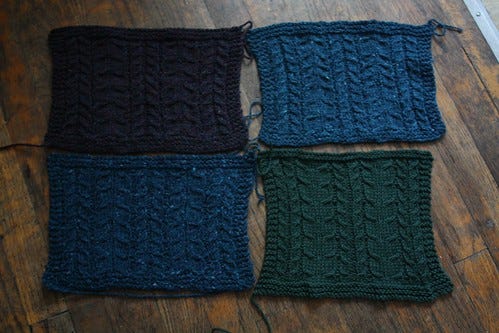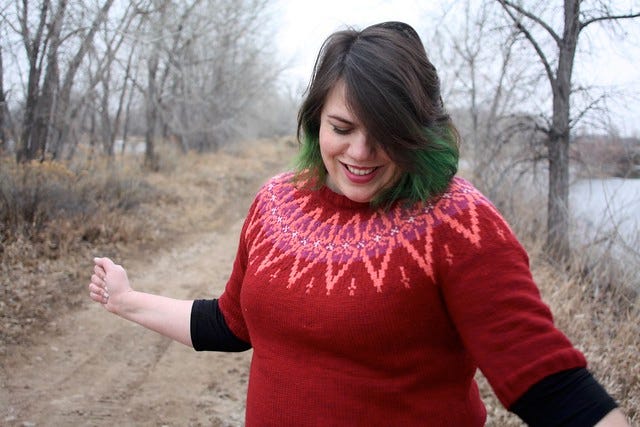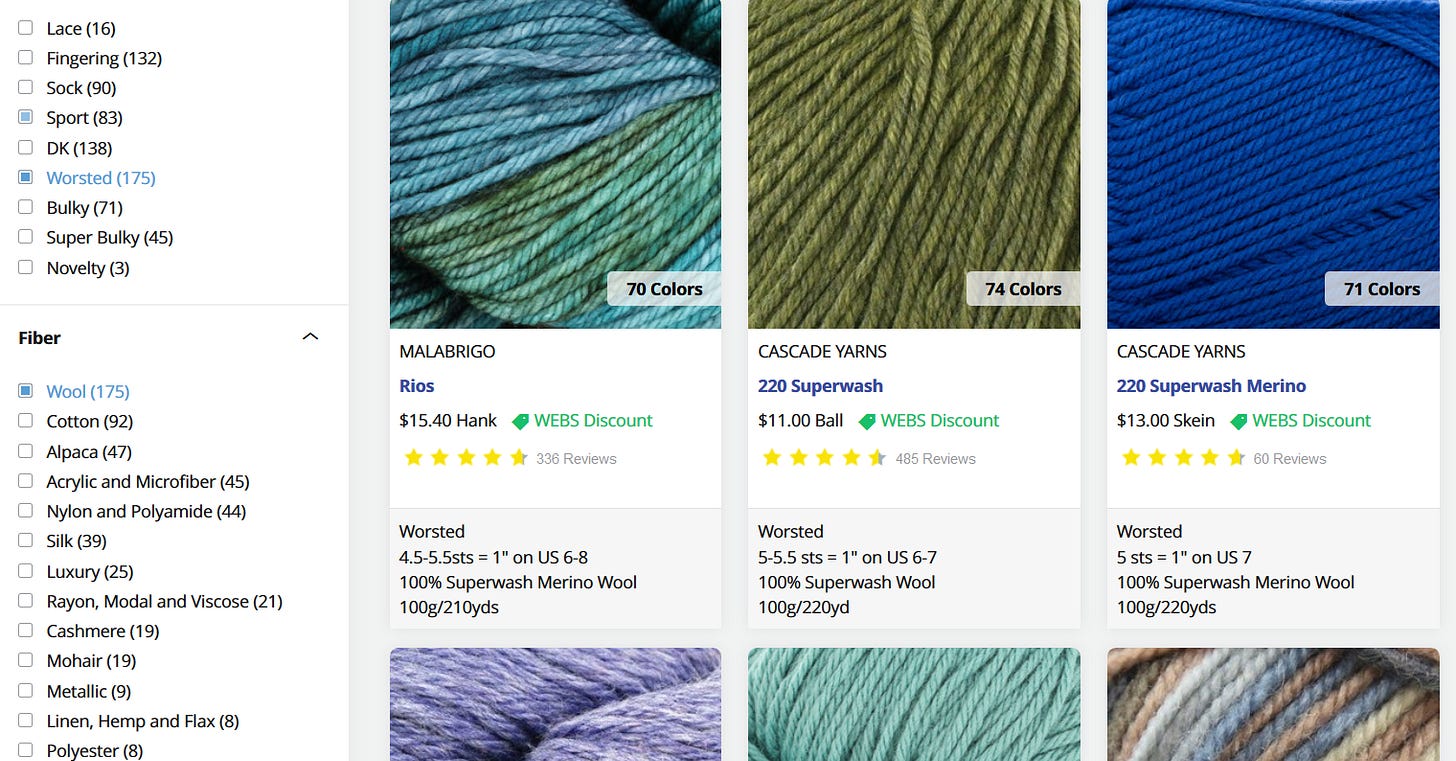Another Blog about Yarn Substitution
I wrote about yarn substitution about six years ago, in this very long blog post. If you’ve been around knitting social media this weekend, you’ve probably seen some discussion around the subject of substituting yarn. It’s part of a much larger discussion, but in the conversations I had with people, one thing kept coming up—some people don’t feel confident choosing different yarns. Hopefully this blog will help people build that skill a bit.
What is yarn substitution?
At the most basic level, it’s simply changing the yarn that is recommended in the pattern for another yarn. Why might I want to change the yarn?
I’m knitting an old pattern and the recommended yarn is long discontinued.
I want to knit from stash and don’t want to buy new yarn.
I’m trying to save money and the recommended yarn is outside of my budget.
I really really dream of knitting this in the most beautiful green/blue/red/whatever shade, but the recommended yarn doesn’t have a color that’s quite right.
The recommended yarn is not available in my country and the shipping is out of my budget.
There’s alpaca (or whatever your nemesis fiber may be) in the recommended yarn and sadly I’ve noticed that it makes me itchy.
I just want to.
There are probably even more reasons than this, but you get the gist. There’s plenty of reasons why anyone could choose to substitute yarn. The trick is how to get the closest substitution to yield the best possible result.
How do I substitute yarn?
As someone who pretty much always substituted yarn from the start, I honestly don’t remember if I read this information somewhere or just figured it out with lots of trial and error, like when I changed up the yarn for my Stonecutter’s Cardigan.
The “easiest” way: find out the CYCA weight of the recommended yarn. It may be listed in the pattern, on the company’s website, or on a yarn shop website. If you can go into a yarn shop, you might be able to find the yarn and look there. The CYCA categorizes yarns from weights 1 through 7, with 1 being the lightest and 7 being the heaviest.
That’s a gross simplification. They’re really based on gauge range—1 will have most stitches to the inch, 7 will have the fewest. But you can also think about them in terms of weight if that helps.
The cons: Real talk, I hate using the CYCA standards for yarn substitutions. There’s too much variation for my tastes and they don’t account for fiber content (which affects drape), but it’s a starting point. Also their terminology is very North America-centric. A British knitting pattern might call for a 4-ply yarn and that’s not a category on the CYCA tables. (Here’s a chart that marries international weight designation with the CYCA table.)
The more complicated but more likely to be accurate way: Better known as “yes, you’re going to have to do some math” way. When I knit my Plum Rondo sweater, I changed up the yarn. I wrote about why I did that in the blog post, but here I’ll show you how below.
The cons: This takes time and a bit of math and an internet connection or cellular service.
Yarn Substitution in Practice
The original yarn recommended in the pattern was Lorna’s Laces Haymarket, which was 100% wool and 215 yards to 100 grams. The recommended gauge was 4.5 to 5 stitches to the inch, which makes it a worsted weight yarn in the CYCA standards. It was also a single-ply yarn. To keep this as short as possible, I’m not going to get into the factors of ply and fiber content. Instead I will recommend to you Clara Parkes’ Knitters Book of Yarn (linked to publisher’s site; this links to the WorldCat Library listing.)
Key things I needed to find: a yarn that had similar yards to gram, a similar gauge, and a similar fiber content. I like to look at yards per gram. So I divide the number of yards in the recommended yarn (215) by the number of grams (100) and I get 2.15 yards per gram.
I went with Stonehedge Fiber Mill Shepherd’s Wool Worsted, which had 250 yards to 113 grams (or 2.21 yards per gram), is recommended at a 4.25 stitches to the inch gauge, and is also 100% wool. Does this perfectly match up with the Haymarket? Nope. But it’s within acceptable range (typically anywhere within .2 yards per gram, so 2.35 yards/gram would have been okay, and within half a stitch per inch is my acceptable range).
Another Example
When picking yarn for my Bronwyn, I knew I wanted to switch out the yarns. Unpopular opinion time, I don’t really like knitting with Brooklyn Tweed yarns. There’s nothing wrong with them, they’re just not for me. So, I looked at the recommended yarn (Shelter) and did my calculations. It’s a 100% wool yarn, with 140 yards to 50 grams (or 2.8 yards per gram), and a range of gauges from 4.25 to 5 stitches to inch.
I like to go to Yarn.com to search for yarns this way. You can filter by weight and fiber content and then easily compare yards per inch on the screen.
I ended up using Kelbourne Woolens Scout for this sweater, which breaks the guideline about yards per gram and gauge just a bit. It’s a 100% wool yarn, recommended at 5-5.5 stitches per inch and 2.73 yards per gram (so .33 yards more). BUT I knew that Shelter is super springy and they actually have the same recommended gauge of 5 stitches to the inch on size 7 needles. I figured I could make small adjustments if I needed to after swatching. (I didn’t, but that’s for another blog post.)
You can do all of this without even touching the yarn (although touching the yarn is obviously the best part of picking out yarns).
Let the Internet Do the Work
If you’re using Ravelry, one of the easiest things to do is to go to the Projects tab of a pattern and see what yarns other people have used. Plus, there’s great inspiration to be had there. But this only works well if there are a good number of projects, so it’s a bit dicey for new patterns.
The website yarnsub.com will also spit out a bunch of results when you plug in a particular yarn. It’s a wonderful tool, though I still prefer to do it myself. I haven’t always been impressed with the results the page has shown me, but I spend way too much time thinking about yarn and find it enjoyable to do this math myself.
There’s obviously a whole lot to talk about with yarns. I’d really like to talk about reasons NOT to substitute yarns. But this is already long and full of words and numbers.
Let me know if you have any questions about any of this and I’ll be happy to clarify!
Do you have a trick you like to use when you’re substituting yarn?






